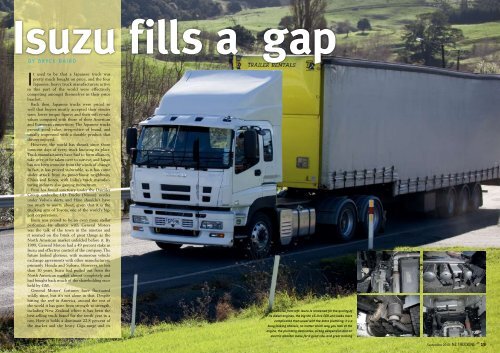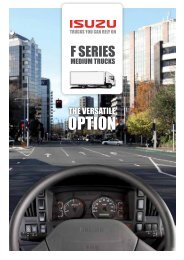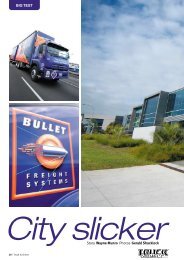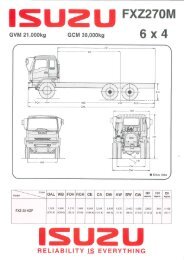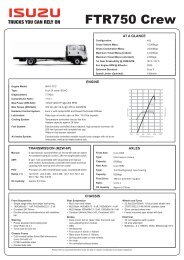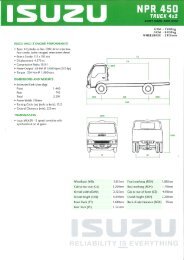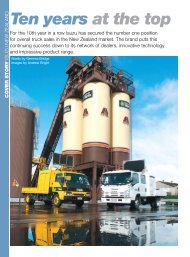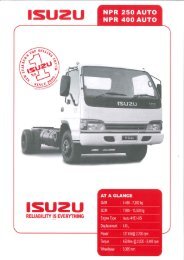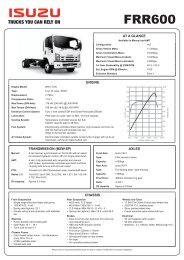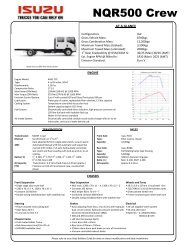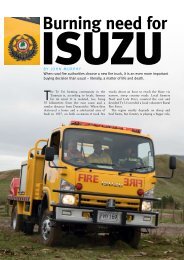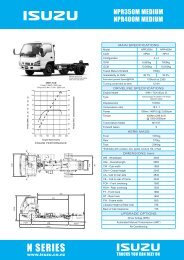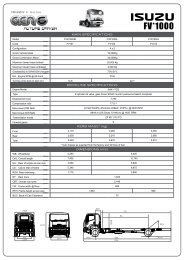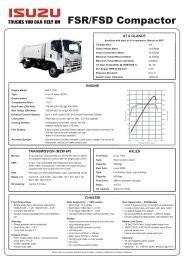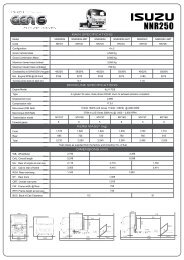By Bryce Baird - Isuzu
By Bryce Baird - Isuzu
By Bryce Baird - Isuzu
You also want an ePaper? Increase the reach of your titles
YUMPU automatically turns print PDFs into web optimized ePapers that Google loves.
<strong>Isuzu</strong> fills a gap<br />
B y B r y c e B a i r d<br />
It used to be that a Japanese truck was<br />
pretty much bought on price, and the four<br />
Japanese, heavy truck manufacturers active<br />
in this part of the world were effectively<br />
competing amongst themselves in their price<br />
bracket.<br />
Back then, Japanese trucks were priced so<br />
well that buyers mostly accepted their stouter<br />
tares, lower torque figures and their soft re-sale<br />
values compared with those of their American<br />
and European competitors. The Japanese trucks<br />
proved good value, irrespective of brand, and<br />
usually impressed with a durable product that<br />
drivers enjoyed.<br />
However, the world has shrunk since those<br />
innocent days of every truck knowing its place.<br />
Truck manufacturers have had to form alliances,<br />
take over or be taken over to survive, and Japan<br />
has not been immune from the winds of change.<br />
In fact, it has proved vulnerable, as it has come<br />
under attack from its powerhouse neighbours,<br />
China and Korea, with India’s truck manufacturing<br />
industry also gaining momentum.<br />
Fuso has found sanctuary under the Daimler<br />
Group umbrella; UD Trucks (Nissan) nestles<br />
under Volvo’s skirts, and Hino shouldn’t have<br />
too much to worry about, given that it is the<br />
trucking arm of Toyota, one of the world’s biggest<br />
corporations.<br />
<strong>Isuzu</strong> was poised to be an even more stellar<br />
performer. Its alliance with General Motors<br />
was the talk of the town in the nineties and<br />
it seemed on the brink of great things as the<br />
North American market unfolded before it. <strong>By</strong><br />
1999, General Motors had a 49 percent stake in<br />
<strong>Isuzu</strong> and effective control of the company. The<br />
future looked glorious, with numerous vehicle<br />
exchange agreements with other manufacturers,<br />
primarily Honda and Subaru. However, in less<br />
than 10 years, <strong>Isuzu</strong> had pulled out from the<br />
North American market almost completely and<br />
had bought back much of the shareholding once<br />
held by GM.<br />
General Motors’ fortunes have fluctuated<br />
wildly since, but it’s not alone in that. Despite<br />
hitting the reef in America, around the rest of<br />
the world it has gone from strength to strength,<br />
including New Zealand where it has been the<br />
best-selling truck brand for the tenth year in a<br />
row. Here it holds a dominant 22.8 percent of<br />
the market and the heavy Giga range and its<br />
Clockwise from left: <strong>Isuzu</strong> is renowned for the quality of<br />
its diesel engines, the big the 16-litre EGR unit looks more<br />
complicated than usual with the extra plumbing; it’s a<br />
busy looking chassis; no matter which way you look at the<br />
engine, the plumbing dominates; airbag suspension and an<br />
electric retarder make for a good ride, and great braking<br />
18 NZ Trucking September 2010 September 2010 NZ Trucking 19
predecessors are widely used in all categories of<br />
cartage.<br />
<strong>Isuzu</strong>’s legacy is still strong in America where<br />
the renowned Duramax engine powers hundreds<br />
of thousands of Chevy and GMC trucks.<br />
Worldwide <strong>Isuzu</strong>’s small diesels can be found<br />
in construction gear, industrial and nearly every<br />
other application, often re-branded. <strong>Isuzu</strong> had<br />
produced more than 21 million diesel engines<br />
by 2009.<br />
Despite a nearly 50 percent drop in truck sales<br />
in New Zealand, <strong>Isuzu</strong> has held its podium placing<br />
but it is well aware that the bigger trucks<br />
coming out of Japan have to work much harder<br />
to compete on the market, as the dollar gap<br />
between the manufacturing blocks isn’t the gulf<br />
it used to be.<br />
Effectively, <strong>Isuzu</strong> and its Japanese compatriots<br />
have seen their financial advantage shrink and<br />
have needed to up the ante in the tougher climate.<br />
Even before the world economic crisis, <strong>Isuzu</strong><br />
New Zealand had been refining its range, and<br />
after more than two years of trying to plug a<br />
hole in their line-up, they’ve presented a brandspanking<br />
new offering.<br />
Colin Muir, sales and marketing manager for<br />
<strong>Isuzu</strong> New Zealand, says <strong>Isuzu</strong> believes it will<br />
be attractive to the skeletal and container crowd<br />
and be cheaper than the EXY530.<br />
<strong>Isuzu</strong> has had a glaring hole in their 6x4 tractor<br />
line-up, as the EXY530 is their smallest – and<br />
only – air-bagged tractor in this market. There<br />
have been other stop-gap alternatives based<br />
around the six-rod suspension EXZ/CYZ400<br />
rigid spec, being converted to air-suspension,<br />
but they’ve not had a dedicated air-suspended<br />
six-wheeler tractor of 400 horsepower on offer<br />
– until now.<br />
Kelly Keogh, the heavy vehicle technical and<br />
product co-ordinator for <strong>Isuzu</strong> New Zealand,<br />
says that in New Zealand the roles are blurred<br />
between the models, due mainly to our small<br />
market limiting options off the production line.<br />
With the EXY400, <strong>Isuzu</strong> have a Euro 4, air-suspended<br />
tractor that is priced considerably under<br />
the EXY530; this gives them a tractor aimed at<br />
the sidelifter and general cartage market.<br />
Effectively it’s a new model for this country<br />
and has refined the range for <strong>Isuzu</strong>. It’s also the<br />
facelift template for <strong>Isuzu</strong>’s future trucks, with a<br />
new exterior makeover. This is just the start of a<br />
list of changes, and this tractor has morphed into<br />
its bigger brother in nearly every respect, except<br />
for the price – <strong>Isuzu</strong> New Zealand has worked<br />
hard to make this truck financially accessible,<br />
without turning it into a poverty-pack model.<br />
The biggest news is that this truck now shares<br />
the same powerplant as its big brother, with<br />
<strong>Isuzu</strong> going back to a big engine to help slide<br />
past Euro 4.<br />
A whopping 15,681cc’s sit under the floorboards,<br />
and that 16-litre 6WG1-TCR engine<br />
may seem like a step back to the days when Jap<br />
trucks often sported plenty of cubes, but modest<br />
outputs. We had a sense of the familiar when<br />
we looked at the spec sheet, and found that<br />
those 16-litres are indeed light in the numbers<br />
compared to other 16-litre units out there, but<br />
there’s a good reason for that.<br />
Four-hundred horsepower and 1300lb/ft of<br />
torque may not take your breath away, but by<br />
using a big engine and bolting on new technology<br />
such as common rail injection, a variable<br />
geometry turbo and a diesel oxidation catalyst<br />
exhaust system, they’ve produced a large engine<br />
that doesn’t need to work too hard. That translates<br />
to lower cylinder temperatures and an easier<br />
pathway to Euro 4 and eventually Euro 5.<br />
The weight penalty isn’t bad either, at only 50<br />
kilos over the previous 14-litre engine – achieved<br />
by a modular construction that allowed a lot of<br />
interchangeability between engines. This engine<br />
has a 147mm bore and a 154mm stroke, and<br />
20 NZ Trucking September 2010 September 2010 NZ Trucking 21
has good torque characteristics with a flattish<br />
torque plateau that stretches from 850/900 to<br />
1650rpm, with peak power running from 1600<br />
to 1850rpm.<br />
What may surprise some people is that the<br />
previous 14-litre Euro 3 engine developed<br />
almost identical horsepower and torque figures,<br />
with a couple of litres fewer capacity. However,<br />
as Keogh points out, “<strong>Isuzu</strong> wants to be competitive<br />
in the market, and more power and<br />
torque means more cost,” when meeting emission<br />
restrictions.<br />
A couple of years ago they had the option of<br />
a 420 with 1650lb/ft, but that proved not viable<br />
for achieving Euro 4 with that 14-litre engine;<br />
meeting emissions is an expensive exercise, and<br />
the small volumes of our market make it a juggling<br />
act to meet our requirements.<br />
This truck is entry level and targeted at markets<br />
such as the container haulage brigade, who<br />
will appreciate the hi-cube friendly 950mm<br />
chassis height, and be unconcerned about high<br />
performance figures.<br />
The EXY tractor shares much with its EXY530<br />
big brother, including the automated 16-speed<br />
transmission, which had a software upgrade to<br />
better use the performance characteristics of the<br />
re-spec’ed 16-litre engine.<br />
For a start, this engine will rev out to only<br />
1850, and a remapping of the transmission software<br />
makes the most of the engine’s changed<br />
characteristics. The 14-litre engine was more of<br />
a revver by nature, and had a narrower torque<br />
and power band, so if you slipped off it, it<br />
needed some quick gear snatching to keep it on<br />
the boil.<br />
The transmission has had internal updates<br />
as well, to improve reliability and durability.<br />
With an under-stressed large engine, <strong>Isuzu</strong> must<br />
want the truck’s engine to accumulate some big<br />
distances before needing major work, and we<br />
suspect they’d like the transmission to be just<br />
A new look for the<br />
EXY, but it is still<br />
recognisably an <strong>Isuzu</strong>.<br />
22 NZ Trucking September 2010 September 2010 NZ Trucking 23
Clockwise from top:<br />
The cockpit layout is<br />
comfortable and easy to<br />
use, with plenty of nooks<br />
and crannies for odds<br />
and sods; easy access is<br />
available to service fulids;<br />
it’s still a three pedal<br />
truck, but that clutch<br />
pedal doesn’t get much<br />
use; the display console is<br />
easy to read, and simple<br />
to keep clean.<br />
as durable. Given that it is basically the same<br />
unit as in the 530, and is capable of handling<br />
2500Nm, we predict durability issues won’t be<br />
an issue.<br />
This particular truck is equipped with a<br />
retarder, an <strong>Isuzu</strong> magnetic driveline unit which<br />
produces 630Nm of holdback, but it is unclear<br />
if this is to be a standard fitting or an option.<br />
There is an exhaust brake, of which we can only<br />
say it is no Jacobs, but with the retarder, this<br />
combination does a great job of keeping the<br />
brake linings cool.<br />
“There is a drive in Japan to get their trucks<br />
more economical,” says Keogh. “This is the most<br />
European or American-feeling engine so far for<br />
us.” Despite having only 6,000km on the clock,<br />
and being driven by a large number of people<br />
with differing driving styles, the EXY400 had<br />
returned 2.1km/l so far – a surprising figure<br />
considering that distance included a Hastings-<br />
Taupo trip loaded to 44-tonne in front of a<br />
B-train. The engine is spinning at just 1620rpm<br />
at 90km/h, which has to help the fuel figures<br />
as well.<br />
<strong>Isuzu</strong> New Zealand wanted to give the truck a<br />
good try out to see what it can do, and although<br />
the truck proved it could do the 44-tonne hard<br />
trips, they see the EXY530 as being the best for<br />
that sort of work.<br />
The EXY400 is more comfortable revving in<br />
the low teens on the tacho where it develops<br />
its torque, rather than in the high teens where<br />
Japanese trucks used to rely on whatever power<br />
they had to get by.<br />
It is a world apart from the old <strong>Isuzu</strong>s we’ve<br />
driven, but while the engine performance is<br />
more akin to a Euro than a Japper, they still<br />
have a way to go before feeling like there’s<br />
an American or European engine under the<br />
floorboards. After all, even the bigger-lunged<br />
EXY530 develops only 2,273Nm (1,676lb/ft).<br />
That, while getting closer to the American<br />
engine torque benchmarks, won’t give an ISX<br />
Cummins sleepless nights.<br />
We took a trip through Auckland to Warkworth<br />
while pulling a three-axle trailer loaded to its<br />
39-tonne stickers. It performed well, but it<br />
noticed the hills, as you’d expect. After all, 400<br />
horsepower is 400 horsepower, but the engine<br />
did seem more willing than we predicted from<br />
the spec sheet, and it is a hard haul up this<br />
stretch of the north.<br />
While the transmission seemed to perform better<br />
than the previous <strong>Isuzu</strong>s we’ve been in, we<br />
wouldn’t be surprised if many experienced drivers<br />
operate it in manual for much of the time on<br />
the open road. It can be slotted into auto mode<br />
and left there, but most drivers would probably<br />
be wanting to curb the truck’s tendency to make<br />
unnecessary changes, particularly when cresting<br />
hills. This happens on every automated transmission,<br />
to a greater or lesser degree, and we suspect<br />
the modest power-outputs coupled with 16-cogs<br />
make the EXY400 want to hunt a little. It’s not<br />
as intuitive as you might expect, and if the truck<br />
ever needed to grab a big handful of gears in one<br />
hit, say drop five or more, it will take its time figuring<br />
out what to do and most likely the driver<br />
will need to take over.<br />
Under normal driving, the transmission is<br />
more than up to the job, and as we said, a driver<br />
could leave it in auto all day on most routes with<br />
no problems. It does long steady grades well,<br />
but on tricky routes like the Arthur’s Pass, you’d<br />
need to keep an eye on it.<br />
It’s a no-frills package: there is no hill-start,<br />
the button on the top of the gearstick gives you<br />
the manual/auto function, and a switch above<br />
your head gives power or economy modes.<br />
As Kelly points out, “It’s an aid to drive the<br />
truck.” Almost anybody could jump in and drive<br />
it, he says, and he’d be right. It is like driving a<br />
big Japanese car.<br />
Like anything, it has its idiosyncrasies, and<br />
we’re not sure what to make of the emergency<br />
shift box on the floor. This facility gives the driver<br />
the option of fifth and eighth gears, as well as<br />
reverse, as emergency options to get home or off<br />
the road in case of transmission problems. We<br />
seldom hear of automated transmissions giving<br />
enough problems to warrant its inclusion, but<br />
it’s good peace of mind.<br />
The transmission is a three-pedal system,<br />
which makes yard maneourvering, backing and<br />
other precision driving easy to manage and old<br />
school. However, most automated trucks these<br />
days are headed to two pedals, but it costs more.<br />
Even though it is only used for yard work, it’s<br />
a nice light clutch that offers excellent engagement<br />
feel. There’s little room around the clutch<br />
pedal for the big-footed amongst us, but that’s<br />
nothing new.<br />
The face-lift has seen changes in the grille,<br />
bumper and sun visor, but step inside and you’d<br />
think you were in the 530. There’s plenty of<br />
interchangeability between the two models, and<br />
it seems that <strong>Isuzu</strong> have got the best of both<br />
worlds with this tractor. It has a great cab, with<br />
plenty of nooks and crannies to hold the modern<br />
truck driver’s daily paper storm, and it’s a large,<br />
light cab with excellent visibility.<br />
As you would expect, 530 pilots get a few<br />
nicer touches such as imitation woodgrain trim,<br />
a six-stack CD player and a hi-roof cab, but<br />
apart from that, the cabs are near-enough to<br />
identical from the driver’s seat. The driver gets<br />
an airbag and Isringhausen 6860 seat (the same<br />
as the 530), a hot/cold storage box, a couple of<br />
overhead lockers and a CD player in the 400. It’s<br />
a pleasant place to spend the day.<br />
Flipping the air-sprung cab is easy, as there’s<br />
an electric motor to do the hard work, as is typical<br />
with a Japanese truck. Once the cab is up,<br />
stand back and marvel at the plumbing. There’s<br />
plenty, a result of the increased amount of EGR<br />
technology bolted to this engine to achieve Euro<br />
4 compliance.<br />
Oil changes are 20,000km apart, and the dipstick<br />
and oil filler hide behind the grille. We were<br />
struck by the tidy cable bundling when we had a<br />
peak at the undergrille layout – it’s quite arty.<br />
<strong>Isuzu</strong> have managed to price the tractor well<br />
by mixing new technology with the tried and<br />
proven. Braking is undertaken by EBS-compliant<br />
drum brakes – a cost-efficient alternative<br />
to discs – but this EXY is fitted with eight-bag<br />
air-suspension. The bags can be controlled with<br />
a remote controller to raise or lower the suspension<br />
height for loading or coupling and, with the<br />
front parabolic four-leaf suspension, the ride was<br />
quite acceptable, with little body roll. It is on the<br />
stiffer side of the equation and is nicely ironed<br />
out by the driver’s sprung seating.<br />
As we’ve come to expect from <strong>Isuzu</strong>, the<br />
in-cab noise was down to European levels and<br />
apart from a bit of wind buffing from the mir-<br />
Left top: The get-home box<br />
– an emergency option<br />
should the transmission<br />
strand the vehicle. It’s great<br />
to see it, but we doubt it’ll<br />
ever get much use; it’s an<br />
<strong>Isuzu</strong>, all said and done.<br />
Middle: Switchery is<br />
minimal, but the truck has<br />
a cross-lock and plenty<br />
of blanks should extra<br />
features be wired in.<br />
Below: New bold styling is<br />
still distinctly <strong>Isuzu</strong>.<br />
24 NZ Trucking September 2010 September 2010 NZ Trucking 25
ors, the truck was exceptionally quiet for its<br />
price bracket.<br />
The truck has HID headlamps, EBS, ASR,<br />
a power-divider and the digital display gives<br />
plenty of info regarding fuel consumption figures,<br />
with analogue dials supplying the majority<br />
of the remaining essentials.<br />
Overall, the <strong>Isuzu</strong> continues a tradition of<br />
offering a comfortable, quiet and pleasant work<br />
environment that is hard to criticise considering<br />
the money spent. Given that the truck is almost<br />
identical to its 530 bigger brother – with minor<br />
differences, it’s the same cab, engine and drivetrain<br />
– this new Giga nicely fills the gap that<br />
<strong>Isuzu</strong> have long been wanting to plug.<br />
The EXY400 has a 24,000kg GVM, and a<br />
GCM of 50,000kg with a curb mass of 7,656<br />
kg, just a tad over the 7,584 kg of the EXY530,<br />
which sports alloy wheels against the 400’s steel<br />
– that partially explains the weight difference.<br />
The extra EGR plumbing and the catalytic converter<br />
to reach Euro 4 probably add a few kilos,<br />
but there’s not much in it.<br />
We can see why <strong>Isuzu</strong> New Zealand have<br />
been so excited by the arrival of this truck – in<br />
the past, they’ve had to make do by modifying<br />
trucks destined for different end use to satisfy<br />
some of their customers.<br />
With the EXY400 they can tick all the boxes,<br />
and indeed, this tractor is likely to be attractive<br />
to those who cart big boxes. Getting air-bags<br />
and a rear frame height of 950mm on a 6 x 4<br />
tractor isn’t all that easy or common, and <strong>Isuzu</strong><br />
are back on track with a model that is sure to<br />
keep the accountant happy, not to mention the<br />
driver.<br />
<br />
S p e c i f i c a t i o n s<br />
isuzu EXY400<br />
Tare weight:<br />
GVM:<br />
GCM:<br />
Wheelbase:<br />
Engine:<br />
Capacity:<br />
Maximum power:<br />
Maximum torque:<br />
Air cleaner:<br />
Clutch:<br />
7680kg<br />
24,000kg<br />
50,000kg<br />
4,300mm<br />
6WG1-TCR<br />
15,681cc<br />
Diameter: 15.5”<br />
Transmission:<br />
Rear axles:<br />
Ratio: 3.9:1<br />
Rear axle capacity:<br />
294kW (400hp)<br />
1765Nm (1300lb/ft)<br />
330mm dual element<br />
Twin plate<br />
<strong>Isuzu</strong> MJX16 AMT<br />
<strong>Isuzu</strong> RT210<br />
21,000kg<br />
Chassis dimensions: 285 X 85 X 7mm<br />
Front suspension:<br />
Alloy steel parabolic leaf springs<br />
Front axle:<br />
Front axle capacity:<br />
Rear suspension:<br />
Steering:<br />
Brakes:<br />
Park brake:<br />
Auxiliary brake:<br />
Wheels:<br />
Tyres:<br />
Electrical system:<br />
Instruments:<br />
Cab:<br />
<strong>Isuzu</strong> FO66<br />
6,600kg<br />
<strong>Isuzu</strong> 8-bag air suspension<br />
Recirculating ball<br />
Full air taper roller<br />
Spring on four rear wheels<br />
<strong>Isuzu</strong> X-tard<br />
8.25’ X 22.5” 10 stud<br />
275/70R22.5<br />
24V<br />
Speedo, air gauges, tachometer, fuel, cruise<br />
control, diff lock, multi-info display & warnings.<br />
Fully trimmed with vinyl floor coverings, ISRI<br />
driver’s air seat, driver’s side airbag, air<br />
conditioning, hot/cold storage box, radio/CD<br />
player.<br />
26 NZ Trucking September 2010


